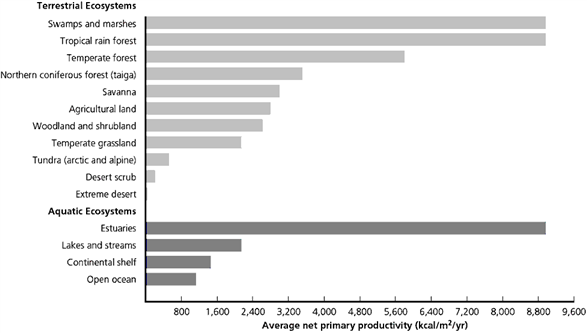
Figure 3.18 Estimated annual average net primary productivity in major life zones and ecosystems pressed as kilocalories of energy produced per square meter per year (kcal/m2/yr).
?
Examine the accompanying figure. Notice the amount of average net primary productivity gets smaller and smaller as you move down the list of terrestrial ecosystems and, similarly, in the list of aquatic ecosystems. What is the common factor in the terrestrial system that causes the decline? What is the common factor in the aquatic system that causes the decline there?
What will be an ideal response?
Terrestrial ecosystems are significantly affected by the amount of water, and consequently, the amount of nutrients. The most productive terrestrial ecosystems are those that have the highest amounts of both water and nutrients. Swamps/marshes and tropical rain forests have significant amounts of water, and therefore have high levels of productivity. When the biomass is recycled, large amounts of nutrients are released and made available. This perpetuates the high net primary productivity. As water becomes less available productivity declines and nutrient availability declines. In aquatic systems, the estuaries are the highest and open ocean the lowest. The common factor would appear to be depth. However, the limiting factors are nutrient availability and the number of available niches. Estuaries are close in to shore where they have available nutrients and fresh water from the land. Sunlight will also be available to all levels. The numbers of niches will also be affected by tidal activity. This provides high levels of variability and high net productivity. In the open ocean, sunlight cannot reach the depths. Biomass in the upper levels will be lost to the depths, taking nutrients with it. In addition, the open ocean is more uniform and does not provide the amount of variation represented in the estuaries.
You might also like to view...
How come an animal's carbon-14 levels do not start to decrease until it dies?
A) because it constantly replenishes its carbon-14 supply by eating plants with carbon-14 in them B) because it constantly replenishes its carbon-14 supply by breathing air with carbon-14 in it C) because it is constantly being bombarded with cosmic rays D) carbon-14 only starts to decay after the animal dies E) The carbon-14 levels do not decrease because the carbon-13 in its skin protects it from cosmic rays.
Calamites was an example of a _________ plant. Fill in the blank(s) with the appropriate word(s)
The area that is now Hong Kong first became part of China during the Han Empire
Indicate whether the statement is true or false
________ are best defined as substances that cause cancer
A) Neurotoxins B) Teratogens C) Carcinogens D) Allergens E) Vectors